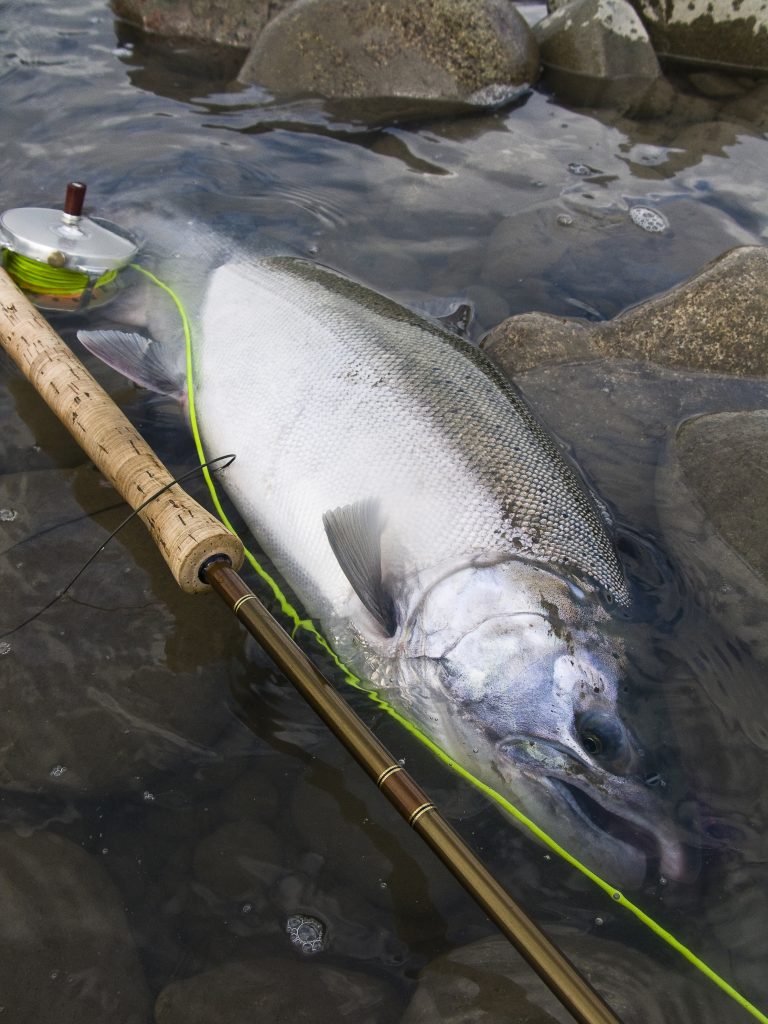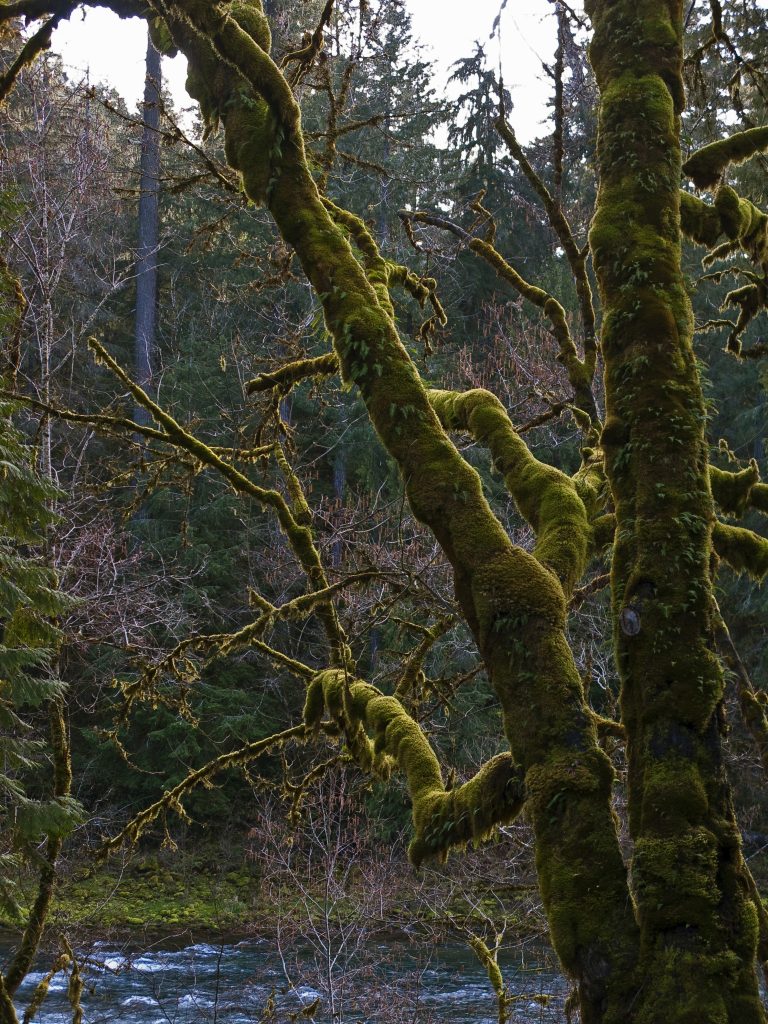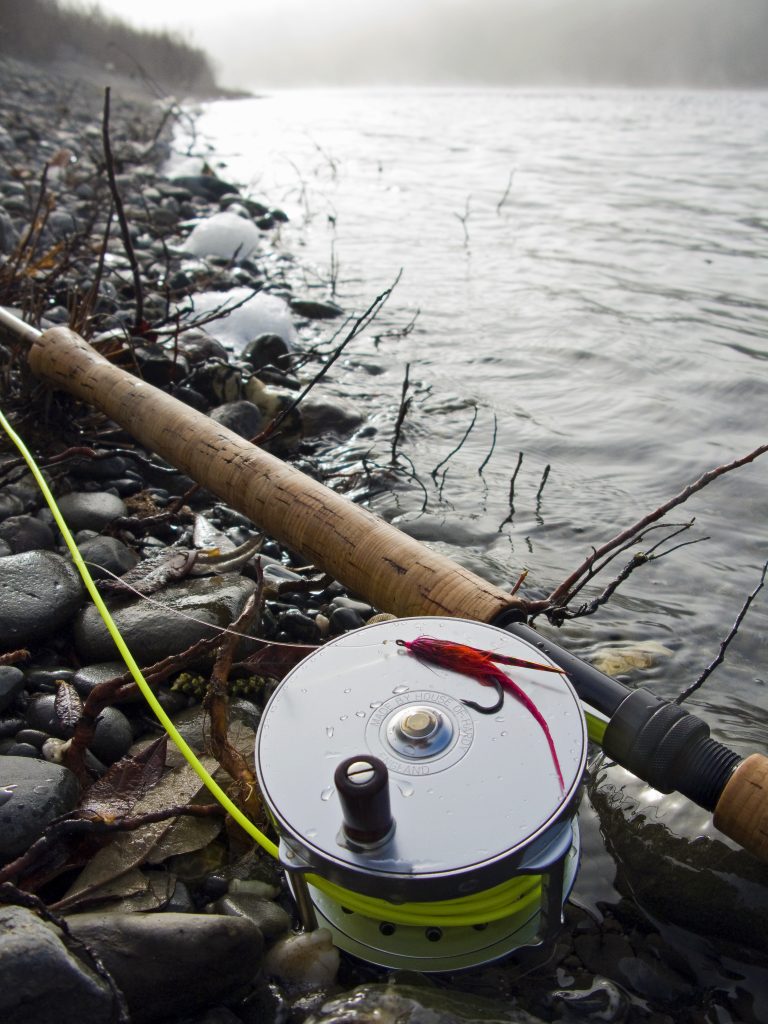This article was originally published in The Contemporary Sportsman Magazine.
Glide, Oregon, North Umpqua River
Light rain is falling, drumming a soft cadence on the roof. Wind rustles the branches of a tremendous douglas fir standing nearby. Beyond the window, the river thunders in its ledge-rock channel, forcing its way westward in a rush to mingle with saltwater, still carving its path in the earth. It’s 10:30 pm and my eyes burn from fatigue; it seems the day started a long time ago. I let my mind drift…and I begin to hear it…the siren song…as old as forever.
It’s early March and throughout the Pacific Northwest, like they have for hundreds of thousands, if not millions of years, steelhead are returning to their home rivers to give life to a new generation. They arrive in their prime: fit, firm and glowing silver, highlighted by the ocean’s prismatic hues. Considering each began as a tiny egg buried in gravel, their return is a miracle of survival and a cause to rejoice. To behold a steelhead — or any salmon, trout or char — freshly arrived from the sea is to look on the exquisite work of Nature’s hand. It is a chance to be astounded, to momentarily catch lightning in a bottle. For this chance, I’m here and ready.

As my head lands on the pillow, details of the day flood my mind: assembling the rod, threading the line, pulling on waders, lacing my boots, choosing a fly — all the cherished rituals of fly fishing. I see the water, tinted like jade, curling around the rocks. A kingfisher chatters and streaks by. A March brown hovers in the air, backlit by a weak sun. And a juvenile fish, also aware of these hatching mayflies, slashes the water’s surface…
I cast across the currents and mend the line. It tightens and a slight bend forms in the rod tip. The streaming flow thrums on the line as the fly slowly swims its arc, dancing just above the rocks on the river’s floor. I hold the line between thumb and finger anticipating the sharp, heavy pull. Everything I am is distilled into these seconds of suspended possibility. Because, once you’ve felt it, you never forget the pull; the sensory memory lingers to remind you. And if you’ve felt it once, you want to feel it again. It’s a powerful, powerful craving.
I want to tell you I caught a fish today. I want to tell you a tale of riveting adventure wherein a great beast swam from the unknowable sea, ascended a frigid, mad-rushing torrent of melted snow and collected rain, and found the path of its prescribed history intersecting mine. I want tell you how this shining creature came delivering a message — to remind us life is a force beyond our grasp; that no matter how precisely we quantify the visible and the invisible, no matter how much we think we know, we are still only a small part of an enormous and enduring mystery.
I want to tell you about the perfect cast and the expert presentation, about the exhausting, noble battle and finally the admiring release. I want to tell you it happened just this way. But I can’t. I can’t because it didn’t happen. I didn’t catch a fish today. I didn’t get a pluck, a tug or a strike. As far as I know, I didn’t get as much as a sniff or a follow. If not for anecdotal evidence, I’d think no fish had returned at all.

But you’ve heard the conqueror’s epic many times before. And there’s ample reason for that. I imagine in the days when our ancestors were being dragged off by saber-toothed monsters, the tales of heroic conquest were needed to bolster collective spirits against mortal terror.
Today the paradigm is radically shifted. We’ve seen ourselves from space. We’ve mastered machines and chemistry. We’ve gained dominion over the beasts. In fact, the beasts are now the ones fighting for survival. You could even say we are the beasts and the beasts are now the innocents simply looking for room to do what they’ve always done how they’ve always done it.
So it is, in the failure to catch or even find a fish, a new mythology rises. The act of “chasing silver” and what it symbolizes becomes as important as fulfilling the conquest — and these wandering fish take on the role of prophetic phantoms. As their numbers dwindle, the significance of each one intensifies. The value of each one encountered is magnified. I don’t think it’s a stretch to say each returning salmon or steelhead is a strike against probability and a victory over natural and man-made impediments. The difficulty of catching them in an artful way epitomizes the challenges of accommodating both civilization and all that is wild on this little spinning rock. The heroic roles are changing. The morals of the stories are shifting.
This morning, when I walked along the river’s edge, I felt the connections that keep me coming back despite the fishless days and frequently inhospitable weather. As I peered through the shifting windows on the water’s surface, hoping and straining to see a long shape ghostly and gray, or a shadow moving on the stones, I felt a fundamental reverence for these migrant fish. Across the ages, and in different ways to different cultures, they have provided sustenance and inspiration, and they have afforded us the indulgence called sport. I felt what has been so aptly described by so many writers before me: a connection with the ancient rhythms of wildlife, rivers and seasons.
It also struck me I was making another kind of connection. I thought about the storied traditions of fly-fishing and realized, in that moment, standing on a rock beside a river in Oregon, I was sharing the hopes of all those who had ever gazed at a river and wondered if the fish had yet returned. There, with my rod and reel and carefully tied fly, I was joining the clan of all anglers who had ever cast a line in the rivers of Scotland, Ireland, Iceland and England; in Norway, Sweden, Finland and Denmark; in Russia; in northern Japan; and on the coasts of North America. How many had stood like me in a similar place but another time with their hand shielding their eyes from the light, in great anticipation of what they might see?

In the eons that sea-run fish have roamed the planet’s waterways, a lot has changed above the water’s surface, and undoubtedly things — some we know and some we don’t — have changed below. I’m sure change will continue to be constant. And I’m overwhelmingly convinced there is a lot to be concerned about when it comes to evaluating and addressing the pressures on our cold-water fisheries. Balancing their needs with man’s needs will surely become even trickier than it is now. But I’m also sure the essential relationships will endure and that there will continue to exist a magnitude of wonders to experience. The bonds between land and sea, season and fish, as well as those between humans and our strong desire to catch fish — and somehow participate in the mythology, new or old — will remain.
Though some days are dark, overall I’m enthused and continue looking forward. As mentioned, I’m here and ready for my chance to be astounded. It’s what keeps me going: knowing that chance is out there. I could tell you about a particular mind-blowing steelhead I “met” in British Columbia last summer, and how I’m still sustained by the rush, but that story will have to wait…
In future issues of this magazine, through this column, I aim to bring you meaningful and provocative thoughts on the unique world of pursuing sea-run salmon, trout and char with a fly and the efforts to keep these special fish returning big, bright and healthy from the world’s oceans. Angling for these fish in their spawning rivers has long fascinated coastal anglers in the northern latitudes and even now, in relatively recent developments, is taking root in unique locales in the southern hemisphere. Intriguing stories are unfolding there — you might say evolution is at work before our eyes — as well as around the globe. In all, there is a lot to talk about.
Jeff Bright is one of the finest freelance photographers and writers on the planet. A self-professed spey fishing fanatic, Jeff Bright’s writing, and photography have appeared in numerous major print and digital fly fishing magazines around the world. As a travel specialist, his expertise includes over a decade hosting and fishing the British Columbia coast for steelhead and Pacific salmon in winter, spring, summer, and fall. When not leading the chase for steelhead in the Pacific Northwest, sea trout in Tierra del Fuego, Atlantic salmon in Russia, or sea-run char in the Canadian Arctic.
« Previous Post



Leave a Comment
No Responses to “A New Mythology by Jeff Bright”